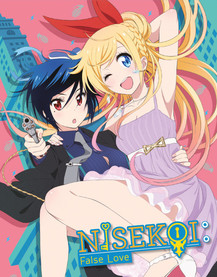Review
by Theron Martin,Nisekoi 2
Sub.Blu-Ray 1
| Synopsis: |  |
||
Chitoge has finally admitted to herself that she's genuinely in love with Raku, but how will she deal with that feeling now when she's around him? Definitely not helping matters is Chitoge's business-executive mother arriving in Japan early for their annual Christmas get-together, a prospect which terrifies as much as it excites her, since her mother can be so intimidating. Meanwhile Seishiro has her own problems with Paula McCoy, a former underworld partner/rival from her days in America, whose challenge to the girl she knows as Black Tiger gets Raku much more involved than either of them are comfortable. Marika also gets her turn for some antics involving a study session and a pet parrot with an “interesting” vocabulary, and everyone gets in on the fun when Valentine's Day rolls around, resulting in all manner of shenanigans involving chocolate. |
|||
| Review: | |||
Nisekoi: is the 12 episode 2015 follow-up to 2014's Nisekoi, and familiarity with the predecessor series is expected. (The intervening OVAs, which are not available in English in any official form, are less important, since some of their events happen amidst the early episodes of this series.) It picks up pretty much where the first series left off, but its first six episodes do little to advance the overall storyline; all that we really get are a few piecemeal revelations, such as the origin of Chitoge's signature hair ribbon. In essence, these episodes consist of a two-episode arc (the one involving Chitoge's mother), two full-episode stories (the ones about Paula McCoy and Valentine's Day), and a collection of half-episode vignettes. Although some romantic comedy anime are ambiguous about whether or not they actually qualify as harem series, there is no ambiguity here: this season is as full-blown harem as they come. Kosaki and Marika were already firmly in loved with Raku, and now Chitoge is too. Seishiro can probably also be added to that mix, since she clearly has more than a passing interest even though she tries to suppress it for Chitoge's sake, and one more – featured prominently in the opener but with only a brief appearance in these six episodes – is still on her way. Paula shows little sign of being won over, but she has only appeared once, and Raku is as phenomenally dense as any harem lead. (In fairness, the only girl who isn't misleading about her feelings is Marika.). As a result, a fair amount of these episodes' content consists of typical harem antics. Not all of it, though. The two-episode arc about Hana, Chitoge's mother, has its share of comedy but also takes a more serious turn about the mother-daughter relationship at its center. The role that Raku takes to bring the two together is anything but a joke, and it's disappointing that Chitoge doesn't acknowledge it more afterwards. The banter between Ruri and Shu also continues to be every bit the bright spot it was in the first series, though it (sadly) gets used only sparingly this time. As a result of all this, the overall effectiveness of the humor tends to be very hit-or-miss – par for the course for this franchise. Also par for the course is the art design, which retains the first series' penchant for being far fancier and more visually creative than romantic comedies normally are. The architecture of the school – both the interior and the exterior – is still a marvel, as is Chitoge's castle-like mansion. The girls' school uniforms still look somewhat dumpy, but any time a character dresses up, they look sharp, as with the red dress that Chitoge wears for the welcome ceremony upon her mother's return. Hana also strikes quite the visual impression, both convincingly gorgeous and remarkably stylish. The shifting perspectives, dramatic expressions, and use of famous pieces of artwork as backgrounds sufficiently disguise the fact that the animation isn't all that special. Accurately describing the musical score without using the word “eclectic” is impossible. The style and instrumentation varies widely, with piano and orchestrated numbers used for more dramatic content and synthesized ditties or other more casual instruments being used for lighter moments. A single opener is used throughout, which is less remarkable for its song than for its nature as a detailed, thoroughly-animated action piece. Four different closers are used in this span: the base one covers episodes 1, 3, and 6, while episodes 2, 4, and 5 have closers keyed to (and sung by the seiyuu for) Chitoge, Seishiro, and Marika. (Each of those characters is featured in that episode.) The format for the release is similar to the first series, being offered only in subtitled form. The case comes inside a single case-sized flimsy artbox and contains two Blu-Ray discs. On-disc Extras only include clean versions of the opener and all four closers, although those versions do have the subtitles that the ones on the episodes lack. Also included in the box are a set of eight end card illustrations of assorted characters done by a variety of different artists. In the end, the first half of the second series sufficiently maintains what made the first series successful, to the point that franchise fans are unlikely to be disappointed. However, it doesn't do anything special, either. |
| Grade: | |||
|
Overall (sub) : B-
Story : B-
Animation : C+
Art : B
Music : B+
+ Can be funny at times, clothing designs, varied musical score |
|||
| discuss this in the forum (10 posts) | | |||
| Production Info: | ||
|
Full encyclopedia details about Release information about |
||